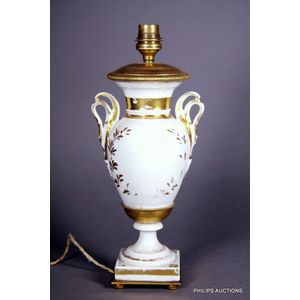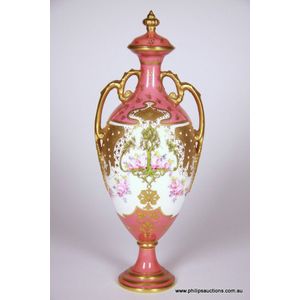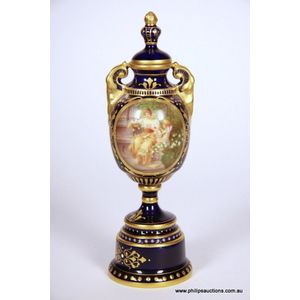German Porcelain Urn with Ram's Head Handles and Jewelled Trims
You must be a subscriber, and be logged in to view price and dealer details.
Subscribe Now to view actual auction price for this item
When you subscribe, you have the option of setting the currency in which to display prices to $Au, $US, $NZ or Stg.
- Finial - An architectural decoration, found on the upper parts of of an object. On furniture they are usually found on pediments, canopies and shelf supports. On smaller ceramic or silver items, such as spoons, they may decorate the top of the item itself, or the lid or cover where they provide a useful handle for removal.
Finials have a variety of shapes and forms. They may be urn-shaped, baluster shaped round or spiral, but usually taper into an upper point. Many real life shapes may also be used as finials, such as pineapples, berries, pinecones, buds, lotus and acorns. Sometimes animals such as a lion are depicted, or fish and dolphins. - Floral Swag / Garland / Festoon - Floral swags are a decorative motif often used in the ornamentation of various objects, such as silverware, glassware, and furniture. The term "swag" refers to a garland or wreath of flowers, foliage, or other decorative elements, which is usually arranged in a loop or curve.
Floral swags can be found in a variety of decorative styles, from ornate Baroque and Rococo designs to more naturalistic Art Nouveau and Art Deco styles. They are often used to add a touch of elegance, refinement, or whimsy to an object, and can be seen on a range of items from chandeliers and candlesticks to picture frames and tea sets.
In the decoration of silver objects, floral swags are often used to accentuate the curves and lines of the piece, and to add visual interest to the surface. Similarly, on glass objects, floral swags may be used to frame or highlight a particular area of the object, or to add a touch of color and delicacy.
On furniture, floral swags can be found on a variety of pieces, from cabinets and armoires to chairs and sofas. They are often used to enhance the lines and curves of the furniture, and can be used to create a sense of movement and flow in the design.
Overall, floral swags are a versatile decorative element that can be adapted to a range of styles and applications, and have been used in the decoration of various objects throughout history. - Jewelled Decoration - Jewelled decoration on ceramics is a technique where small, colourful, and often metallic beads or "jewels" are applied to the surface of ceramic objects to create intricate and highly decorative designs. This technique has been used throughout history and across different cultures, but it was particularly popular during the late 19th and early 20th centuries, especially in Europe.
The jewelled decoration is usually applied by hand, one bead at a time, onto a base glaze or enamel. The beads can be made of glass, porcelain, or even precious stones, and are often set in a metal setting, such as gold or silver. The end result is a highly decorative and often luxurious surface, which can add a lot of visual interest and value to the ceramic object.
Jewelled decoration was used on a wide range of ceramic objects, including vases, plates, bowls, and figurines. It was particularly popular in the Art Nouveau and Art Deco periods, where it was used to create highly stylized and ornate designs.
This item has been included into following indexes:
Visually similar items

A Paris Porcelain lamp base, 19th century, the white baluster lamp with gilded trims, having pierced high set handles, a waisted neck and a footed socle to a square base, with engine turned gilt bronze mounts with guilloche, gadroon and beaded decorations,

A Royal Worcester floral twin face handle lidded vase (height 34 cm with hand painted floral mide section, double face themed handles, fluted neck and base and acanthus leaf decoration to bottom mid section, stamped to base with emblem and (Rd 1911), heigh

An Edwardian Royal Crown Derby vase with cover. 1901, the slender ovoid pedestal vase with a small trumpet neck, a scrolling leaf form gilded handles and a domed cover, decorated with a deep shaped border of pink roses and other blooms within a green bower

A signed Vienna porcelain covered urn, circa 1880-90, signed Kosnor, the ovoid pedestal urn raised on a high stepped base, having scrolled lug handles and a turban top finial to the cover, with a medallion decorated with a Grecian woman accompanied by a cu
